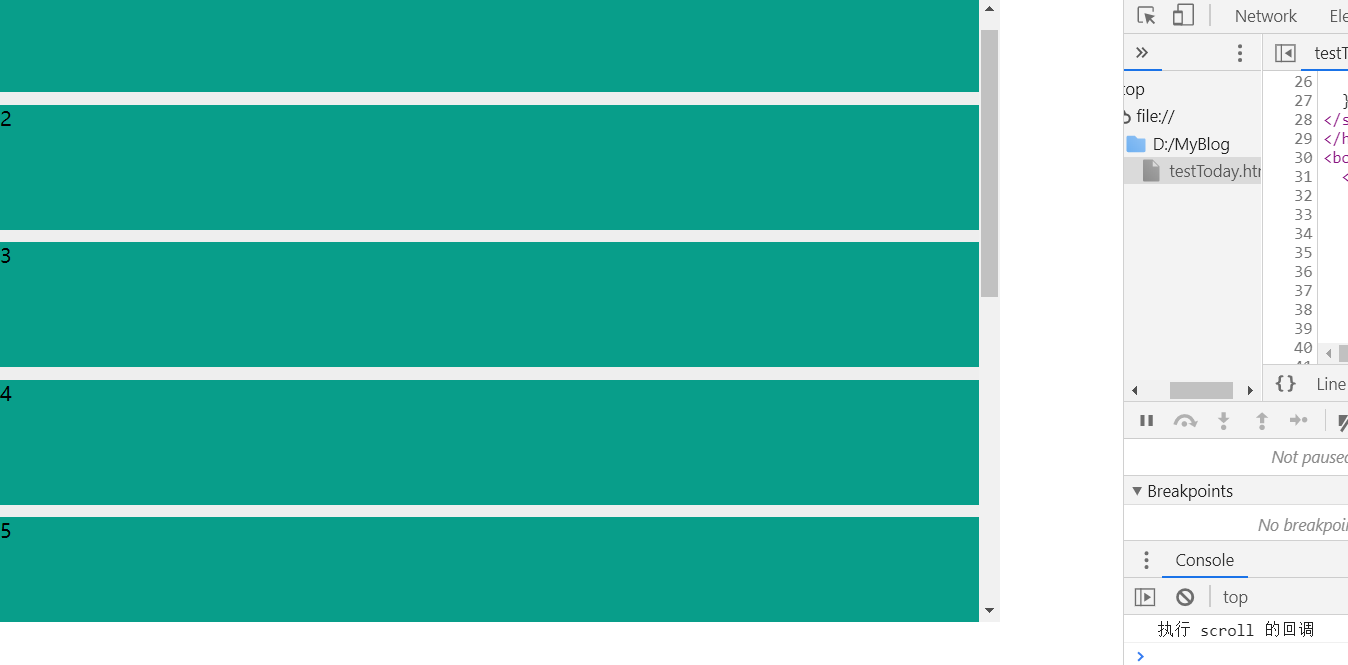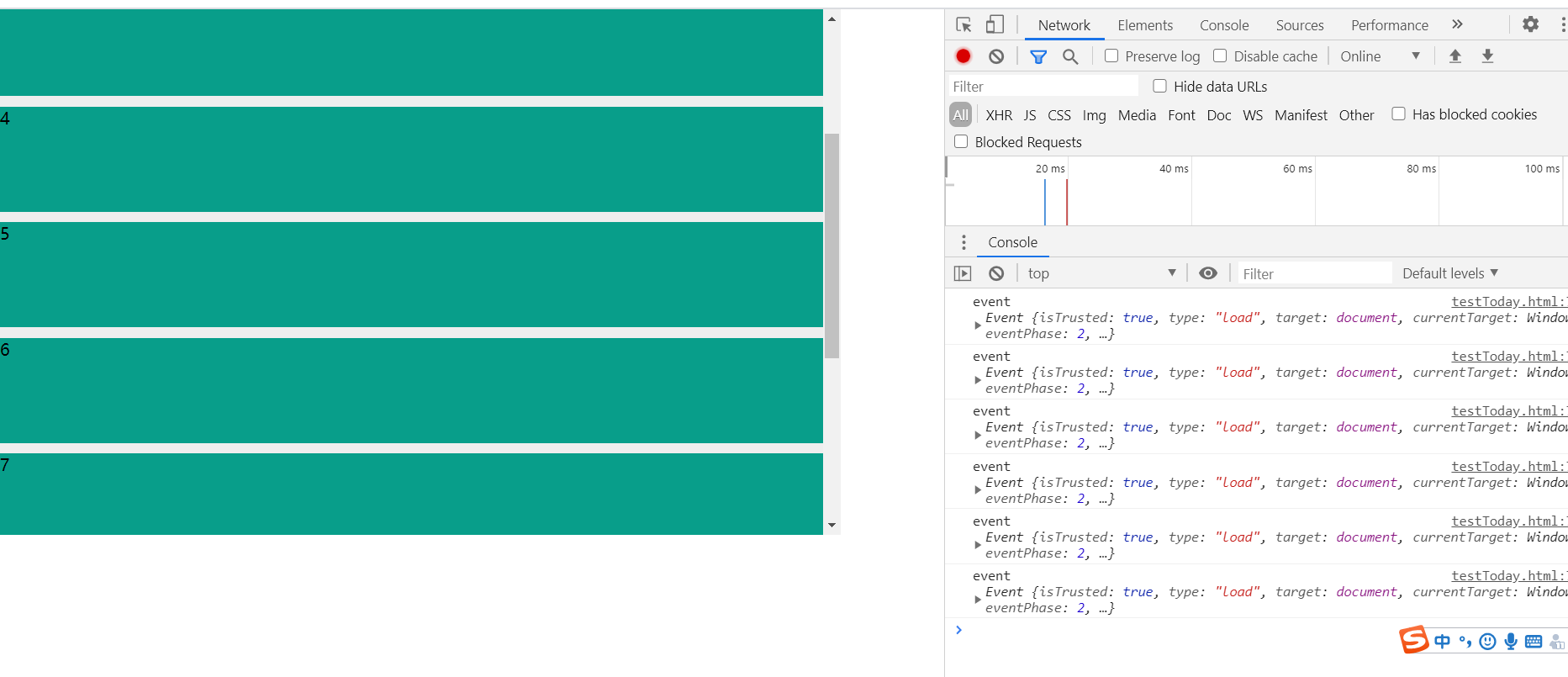标签:元素 场景 pre last hub ttl ini child set
试想以下场景:
很多时候,我们不需要实时地去反馈。这对机器的性能要求太高了,并且不太必要,所以有了以下的解决方案:
1、防抖:假定一个停顿时间,如果下一个操作和上一个操作的间隔不够一个停顿时间,我们就取消操作的想法。
等喋喋不休的人彻底(并不是永远,而是泛指一段规定的时间内)安静下来,我们再阐述道理。
2、节流:假定一个间隔时间,在持续操作的时候,按照间隔的时间触发。
有间隔地回复喋喋不休的人。
<!DOCTYPE html>
<html lang="en">
<head>
<meta charset="UTF-8">
<meta name="viewport" content="width=device-width, initial-scale=1.0">
<title>Document</title>
<style>
html, body, ul, li {
list-style: none;
margin: 0;
padding: 0;
}
.wrap ul {
width: 800px;
height: 500px;
background-color: #eee;
overflow-y: scroll;
}
.wrap ul li {
width: 100%;
height: 100px;
margin-bottom: 10px;
background-color: #089e8a;
}
.wrap ul li:last-child {
margin-bottom: 0;
}
</style>
</head>
<body>
<div class="wrap">
<ul id="ul">
<li>1</li>
<li>2</li>
<li>3</li>
<li>4</li>
<li>5</li>
<li>6</li>
<li>7</li>
<li>8</li>
<li>9</li>
<li>10</li>
</ul>
</div>
</body>
<script>
window.onload = function () {
// 获取滚动父元素
const oUl = document.getElementById(‘ul‘)
// 编写防抖函数
const fn = function (delay) {
let timeout = null
return function() {
if (timeout) {
window.clearTimeout(timeout)
}
timeout = setTimeout(() => {
console.log(‘执行 scroll 的回调‘)
arguments.callee(delay)
}, 1000)
}
}
oUl.addEventListener(‘scroll‘, fn(1000))
}
</script>
</html>

接下来我们可以尝试着优化我们的 JS 部分,让停顿下来后,需要执行的函数,与我们实现防抖的部分分离。
window.onload = function () {
// 获取滚动父元素
const oUl = document.getElementById(‘ul‘)
// 编写防抖函数
const debounce = (fn, delay) => {
let timeout = null
return () => {
if (timeout) {
window.clearTimeout(timeout)
}
timeout = setTimeout(fn, delay)
}
}
oUl.addEventListener(‘scroll‘, debounce(() => {
console.log(‘我是防抖的事件‘)
}, 1000))
}
上面的写法没办法帮我们把 event 传进去,这里我们要把当前的作用域也传进去
window.onload = function () {
// 获取滚动父元素
const oUl = document.getElementById(‘ul‘)
// 编写防抖函数
const debounce = (fn, delay) => {
let timeout = null
return () => {
const me = this
const args = arguments
if (timeout) {
window.clearTimeout(timeout)
}
timeout = setTimeout(() => {
fn.apply(me, args)
}, delay)
}
}
oUl.addEventListener(‘scroll‘, debounce(function(event) {
console.log(‘event‘, event)
}, 1000))
}
window.onload = function () {
// 获取滚动父元素
const oUl = document.getElementById(‘ul‘)
// 编写节流函数
const throttle = (fn, threshold) => {
let timeout = null
// 这里是闭包的关键,它存储在内存中,帮我们记录
let last = new Date()
threshold = threshold || 500
return () => {
const me = this
const args = arguments
let now = new Date()
/*
* 第一次进入,进入 setTimeout
* 节流时间内进入,走 else,删掉上一次的 timeout
* 一直到节流时间后进入,直接进入 if 块里面,直接执行
*/
clearTimeout(timeout)
if (now - last >= threshold) {
fn.apply(me, args)
last = now
} else {
timeout = setTimeout(() => {
fn.apply(me, args)
}, threshold)
}
}
}
oUl.addEventListener(‘scroll‘, throttle(function(event) {
console.log(‘event‘, event)
}, 1000))
}
老实说:直接手写的话,还是要理解透彻有点。或者,多写几次。

todo.
标签:元素 场景 pre last hub ttl ini child set
原文地址:https://www.cnblogs.com/can-i-do/p/13062167.html